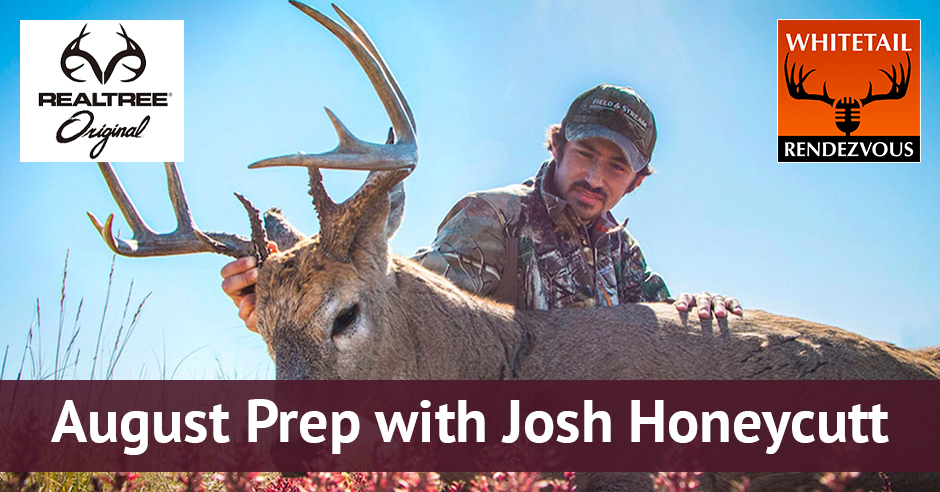
—
Listen to the podcast here:
August Prep with Josh Honeycutt
I’ve got Josh Honeycutt with me. We’re going to talk about August prep. Josh is the Deer Hunting Editor of RealTree.com. Josh, welcome to the show again.
Bruce, thanks for having me on. It’s an honor.
It’s always a pleasure. I enjoy talking with you, learning more about what you know and how will you share in the written word so props to you. Josh, let’s jump right into it. What do you want to tell my audience about what they should be doing right now? It’s August, the season. I saw a monster whitetail on social media, taken in Florida. It’s a huge one. Guys are deer hunting already. What should people be doing right now to get ready for September opener for whitetails?
I don’t do a lot to be honest. I traditionally don’t do a lot in the month of August because I prefer to get it done already. I’m going to talk about both sides of that if that’s okay. Here in Kentucky where I’ve been hunting for a long time, I traditionally get everything set up and done well and advanced because hunting properties that I’ve been hunting for a while now. It’s properties that I have permission on. I don’t own land. They are properties that I’ve had long-standing permission so I try to get as much stuff done earlier in the year as possible. You’re doing your post-season scouting right after the season closes during the winter and early spring. Getting any permanent set stands hanged that you’d want, that you know are in good locations, get that done no later than mid-summer or early summer.
I don’t do a lot of work in the field during the month of August, but I do some stuff here at home. The more stuff you can get done before August, the better because our season opener is September 7th. If you can give them that at least a month, if not buffer, that you have to go into the field, bade and mess up any type of pattern they might have, the better. If you can give them, even more, two months, that’s great. What I’ll do is I try to get everything set up stands, blinds. You’re planting fall food plots, you’re going to go in there and plant fall food plots during the month of August or September.
Be ready for the hunt of a lifetime. Preparation is the key to your success. Share on XAs far as being in there, leaving a scent and being somewhat intrusive, I try to get that stuff done well before August. In that scenario, all that I do during the month of August is if I’m planting any last-minute micro plots, I’ll plant those towards the middle of August usually. It depends on rain. If we have rain in the forecast, I’ll jump on it. Sometimes it can go from early August to early September depending on what the weather, the temperature and the specific scenario might be. That’s obviously something that I do during the month of August. Something else that I continue to do is monitor trail cameras. I’ll check cameras once a month during the preseason so I’ll check them around the end of July. I’ll check them again around the end of August.
That’s something that I do, but that’s only one time in the field. I try to make sure I keep in mind wind directions when I’m doing that and leave as little ground set as possible. That’s something I’m obviously doing in August. I don’t do a lot of tree stand work during the month of August under this scenario that I’m talking about right now. If I don’t get a tree stand hung that I want hanged in a location by say mid-summer, I’m not going to go in there and hang that stand at all. What I’ll do is I will go in and hang and hunt once the season opens. I feel like you’re better off that way. If you try to go in there and hang a tree stand under this scenario, you can do more harm than good by trying to go in there a couple of weeks before the season or a week before the season and hang that stand.
Now I’m not saying every situation is like that, but most situations in most stand locations you can do more harm than good. It’s better to pack in on your back and carry your stand and sticks or whatever types of climbing mechanism you’re using and do it the day you go in there to hunt and maybe that’s open in the day. Maybe it’s a couple of days after the season, whenever that might be especially for an early-season spot. If you have like rough spots that you know you’re not going to be hunting for a few months, that’s a little different. As far as early season prep goes and getting things ready for that first week or so of the season, I would rather go in and hang and hunt, and not hang that stand if I haven’t already got it done within a month to two months of the open.
How many trail cameras are you running?
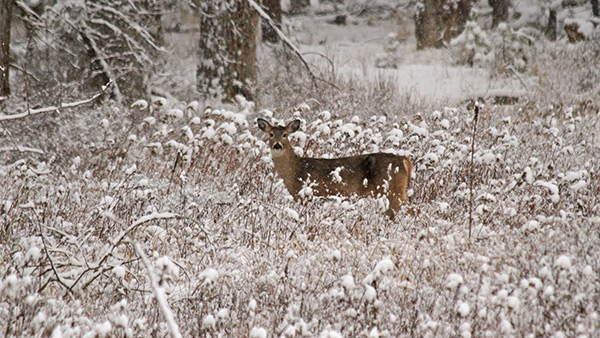
It varies. Right now here in Kentucky, I want to say that I’ve got about 35 but that’s spread over four different properties. Those properties range anywhere from 50 acres to about 250 acres.
You’ve got 35 so you’d have to pull 35 cards?
I don’t do that all in one day obviously. All of these properties are pretty close to one another. I would say they’re within a 30-minute radius of one another. Usually, when I do camera checks, it takes about two days. I won’t do it early in the morning and I won’t do it late of an afternoon when deer are moving. I’ll keep it between say 9:00 or 10:00 and maybe at the latest 5:00 in the afternoon. This is all Central Time from me. The first few hours of the day in the last few hours of the day, I don’t check trail cam because I don’t want to go in there and bump deer that might be moving. I try to make sure that I’m doing my camera checks while they’re still bedded down. With that, it usually takes me about two to three days, two days at best, three days at worst to get all of that done.
You put them out in June or early July, is that when you put your trail cameras out?
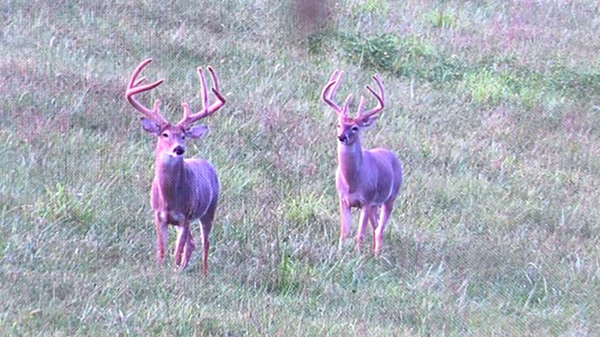
I typically put them upright around June 1st, a little right on or a little after. I’ll usually let my cameras go until antler drops. I’m running cameras from around June 1st until around the end of March.
You’ve got a pretty good idea of what’s coming and what went through hunting season. You can take a look and say, “Here’s the information I’ve got. Here are the bucks that made it through.” You can set up and think about the coming season.
A good point to this is a deer that I’m potentially be hunting this fall. He’s a deer that I call Tanker. I’m not a big guy when it comes to naming deer. He got the name Tanker. He’s a deer I’ve been following for a few years now. He’s a mainframe 148, but he’s got split twos, split threes on his right side. He’s probably got about four or five times that are all two to three inches each. All in all, he’s about 160-inch gross, not typical. This is a deer that followed for a few years. I may change that. There’s some other deer that I’ve got my eye on. I don’t know for sure that I’ll hunt this deer but if I do, it will be the first time that I’ll hunt him even though I followed him for a few years now.
To your point, figuring out what deer made it through this season and having a year-round scope and a year-round perspective, you gain a lot of entailed during that time too. Obviously, I knew that that deer was still alive because I had pictures of him all the way up until he shed his antlers. Interestingly enough, his core area doesn’t change very much between the early season and late season either. There’s a slight shift during the rut. He tends to move a hair further north during the rut. He’s a pretty big homebody. That’s a pretty good example of what you’re saying. Being able to have those cameras up, I knew whenever he dropped his antlers that more than likely he was going to be back again for the 2019 season. Sure enough, unless something’s changed since I glassed him from afar, that’s still the case.
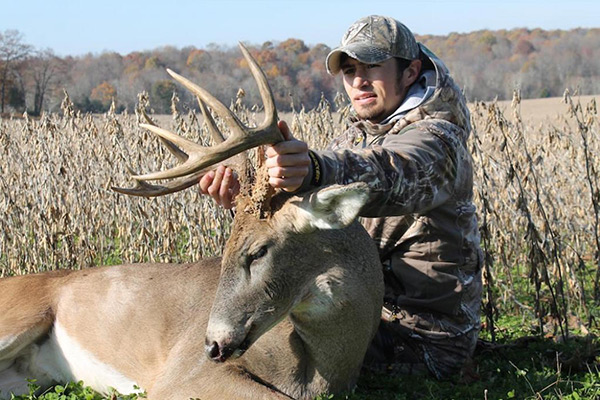
You’re big on long-distance scouting, aren’t you?
Yeah, and that’s the thing that I was going to talk about the most. That’s my biggest, I guess so to speak during the month of August is glassing from afar. I can’t do that on every property that I hunt. I’m on some hills and some haulers that don’t have big bean fields or big ag fields. I can’t do that everywhere I hunt. There are some places that I can, and this was one of them. That is something that I like to do during the month of August. I like to get back off the deer and glass one from afar. Trail cameras are good, but they don’t tell the whole story. Trail cameras while they verify that deer are there and they can even tell you which direction they’re bedding, which direction they’re feeding.
Whenever you look at that first photo and that series of photos that you get or the last photo in the series of photos that you get, what direction the deer is pointing and that gives you a lot of information. You’ve got to have your trail cameras set up in the right way to maximize the validity of that first photo because a deer meander, they twist and turn. You’ve got to make sure you’ve got your cameras in a position where that tactic is most reliable. Trail cameras can be deceiving. I definitely like to glass from afar or on properties that allow that based on the terrain and whether there are big open fields or not. It is a helpful tool for me. It’s no different than the concept of hunting from an observation stance. It’s the same concept if you’re doing it early and during the summer before the season opens.
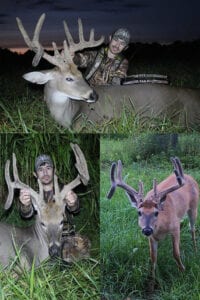 How do you keep track of all this information? 35 cameras, I don’t know how many frames you get from each camera if you let them run for a month. That’s a lot of data. How do you organize that? I get people like myself who are scratching ahead. How do you make sense of that?
How do you keep track of all this information? 35 cameras, I don’t know how many frames you get from each camera if you let them run for a month. That’s a lot of data. How do you organize that? I get people like myself who are scratching ahead. How do you make sense of that?
As far as trail cam locations go and trace down locations go, I have apps on my phone for that. Back before apps, I would mark them on aerial maps. I would plot where my stands and my trail cameras look before I started doing that, I would forget where they were. I’d be walking through the woods after deer season and like, “I put that camera out a year and a half ago. I thought I lost it.” I had, but I have forgotten where I put it. What I do is I use three different apps. I use onX. onX is great when it comes to looking at typography, looking at the different map layers that they have. I use onX for that.
As far as keeping my tree stand locations straight, I’ll mark all of my stand locations, whether it’s actual permanent sets that I already have or potential spots for hanging hunts. I keep track of all of that in HuntStand. I keep track of all of my trail camera locations in Scout. Now you can do all of that in one app, but I have found that sometimes, especially on the mobile versions of those apps, you can get clobbered up. Whenever you put too much information on those maps, it gets difficult and things start to blur together. I found it simpler to do it that way. As far as keeping trail camera photos straight, I never delete a trail camera photo.
I have hard drives that have got probably over 500,000 photos. I don’t delete them. I keep them because that’s valuable information, especially if you’re hunting the same property from year to year. Even if you’re not, there’s so much you can learn by studying trail cameras. You’ve got to put in a little effort to do it. The biggest lesson when it comes to studying trail cameras photos is looking at the date and the timestamp on that trail camera photo. Looking at the behavior of that deer, how it was acting, whether it was a nighttime or daytime photo. The nighttime stuff, I don’t study that as much, but anytime I get a daylight trail camera picture of a mature deer, I study that thing.
Trail cameras are good, but they don't tell the whole story. Share on XThe best way to do that is to go back and look at the historical weather data on that day at that time for that specific location that deer was in. Most of the time you’re looking at wind directions. You’re looking at it in correlation with what direction that deer came from especially if it’s an afternoon. Let’s say it’s an afternoon. If it’s an early afternoon or late afternoon trail camera photo, you want to look at that first photo in a series of photos in whichever direction his butt is pointing in. More times than not, if you have your cameras in a good location to take advantage of this tactic, it’s going to point towards the bed. The same thing in reverse, if you have that thing set up on a trail, it’s between bed and feed and it’s early morning after daybreak, whichever direction his head is pointing in is the general direction more times than not his bedding area. That’s not always foolproof. It’s not 100%. I don’t know exactly how effective it is. If I had to guess, I’d say that tactic is about 70% accurate, maybe 75%.
I’ve heard stories deer doing this, I’ve seen deer do it myself. Sometimes deer will come in and fish up in front of a camera, especially if you’ve got like a mock scrape out or if you’ve got bait out, if you’ve got mineral out, sometimes those deer will circle down into that camera or that mock scrape or that scrape or that bait site or that mineral lick, whatever it is. If you have something in front of that camera that’s drawing the attention of deer, a lot of times a matured deer will fish hook and come in from the downwind side. It’s not always accurate, but depending on the buck’s individual personality, not all deer do that. It’s something to keep in mind. You don’t want to 100% go on that particular tactic, but it’s something that has proven to be effective for me throughout the years.
I’ve known some people keep track of barometric pressure. They keep track of the wind. Also, they keep track of the moon phase. You get all this data because once it’s time and date stamp, you know what has happened, weather-wise. How important is that to you?
I put the most stock in two to three things. The first thing I look at when it comes to studying these pictures is wind direction because you’re not going to have a weather event every day or even on every day that you get a daylight photo. The biggest factor, it’s far away the most important is what direction that wind is blowing in whenever you got that daylight trail camera photo. I’m not saying deer are walking into the wind with their nose into the wind every day. That’s not the case. If it was, every day would be sunbathing over there on the Pacific. That’s the most important factor. I also like to pay attention to the particular rain events. If there was a pop-up shower on that day, pop-up showers, especially when late in the afternoon tend to get deer up on their feet a little sooner.
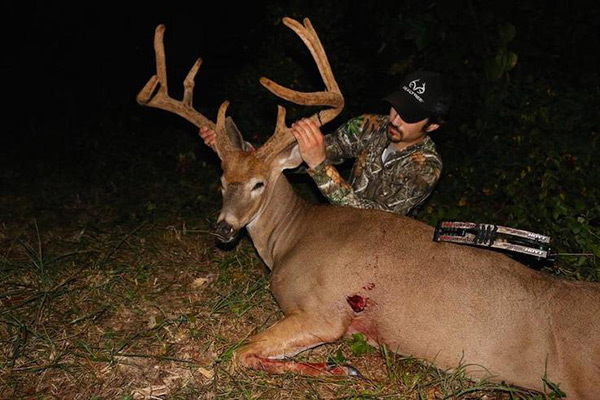
I’ve seen it happen too many times for it not to be true. That’s something that I’ll look for is rain events, maybe a little pop-up thundershower. Obviously big fronts, I’ll go back and look for those as well. The weather is the key thing. I don’t personally pay much attention to the moon phase. I know a lot of hunters do it. I’m not saying they’re wrong, but I’ve personally not seen a huge correlation in my own hunting and my personal recreational research. I’ve not seen as much of a correlation in movement and moon face. What I do think that there might be something too, the jury in my mind is still out on that. I’m still trying. I know there’s been other research on it. I’m not questioning that research, but as far as verifying it and studying it on my own, there might be a little something to it.
I don’t know how big of an influence it is, but that is the moon position, not moon phase but moon position. There’s the talk of the overhead underfoot. Whenever the overhead and underfoot line up with dawn and dust, a lot of the times that can spark some daylight activity. That’s something that everybody can draw their own conclusion on. That’s something that I go back and look for to see if that overhead under foot correlated with dawn and dusk or correlated with the timing of that daylight trail camera photo.
I’m thinking about the moon and I used to fish by the moon, the moon phases. I knew when fish are going to hit especially trolling in Lake Michigan and also in saltwater. I found it worked for me. Having said that, I’ve talked to enough people throughout the podcast that it waivers. Here’s what I’d say to our audience. If you believe in the moon phase, follow the moon phase, charting the moon phase and if you’ve been successful in the moon phase, keep doing it.
If something’s working for you, something is working for this. That’s cool.
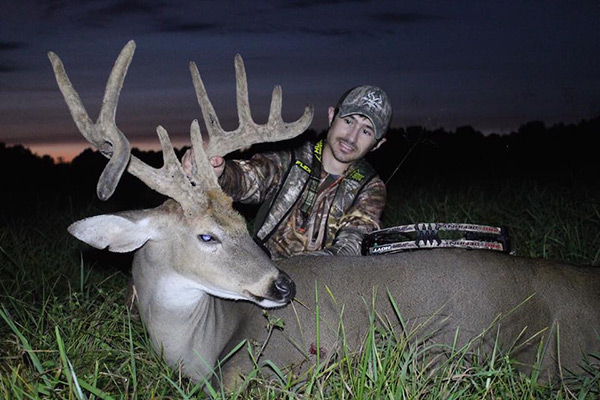
Keep doing it. Let’s talk about practice. I know you’re an archer. How much do you practice throughout the year and are you practicing more or less during the month of August?
I wanted to say something else on that other topic briefly. I don’t practice as nearly as much as I should. I should get a smack on the wrist for that. I still do shooting my bow, absolutely. I’ll probably don’t shoot it as often as I would like because I’m busy. It’s something that I have a personal goal to get better at. Now I feel like I’m a pretty decent shot. I hold my own. I used to go and shoot some 3D archery tournaments and did pretty well. It’s one of those things where some people can go out there and not shoot their bow for months and pick it back up and they’re shooting as good as they did before they took their little break from their routine. Some people have to shoot on a schedule regularly to maintain what they’ve built up. The biggest thing when it comes to shooting a bow and getting prepped is to figure out which category you’re in and make sure you tune your practice prescription, so to speak, to what you need individually, personally.
I learned this a long time ago from a pretty good archer. He said, “Bruce, as it gets close to the season, take one arrow and go out into your backyard, whatever that is. You should know about your backyard. You can ethically kill a deer. Set that up, take that one arrow and shoot it, see where it goes.” You’re back into your 40-yard pin, 30-yard pin and twenty-yard pin because most deer killed twenty or 30 yards, most whitetails are killed at twenty or 30 yards. Is that a fair statement?
I would think so. I don’t have any research in front of me, but I’ve heard that statistic quoted. That’s exactly what my practice regimen is during the last couple of months leading up to the season. I don’t go out there and shoot 30 arrows. I never do that. I never go out and shoot 30 arrows, unless I’m shooting like a 3D course. I might shoot that many, obviously, between some practice and the actual course itself, I might end up shooting quite a few arrows on a day like that. When I’m out here in my yard, I’m at home, maybe it’s an afternoon or it’s a weekend or whatever it might be when I shoot my bow, I do exactly what you said. I’ll shoot mine all the way out to about 70. I don’t shoot whitetails at 70 yards, but I’ll shoot one arrow all the way out to 70. I’ll come back and shoot one more at 20 or 30. I’ll start at 10, 20, 30, 40, 50, 60, 70 and I’ll come back in and finish up an arrow at twenty. My maximum yardage is about 40. I have shot a deer out to about 50, but I set at myself at the limit of 40 yards. I shoot at those longer distances to prove my skill and my confidence at those ranges where I do shoot a deer.
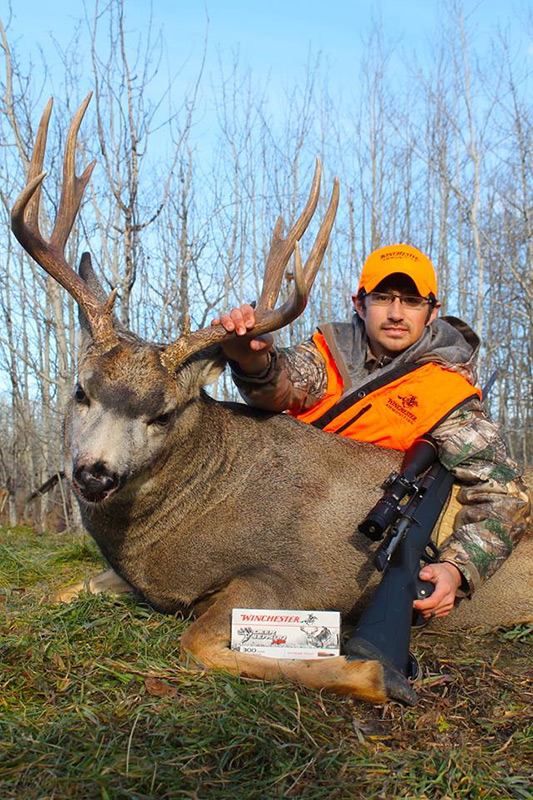
The buck you got the last time, how close was he?
I want to say he was 25 yards.
You watch him come all the way across, didn’t you?
I watched him come all the way across that opening two days in a row. That’s about how far he was about 25 yards.

The first time you saw him, how far away was he?
I saw him on the fourth day of the season if I remember correctly. I was in one stand location. When I first saw him for the very first time on the fourth day of the season, the day before I killed him that would have been about 150 yards, probably was whenever he first came out. I figured there’s a good chance he could do the same thing the next day because the wind direction was going to be the same, had an easterly-ish wind both days and it was projected to be the same the next day. I was like, “If he comes out right there on an east wing and he’s probably going to do it again, it was at least a good chance because I know he’s still going to the same food source services, soybean field to the south on the neighboring property.
He was betting on us. He was running north to south from bed to feed and the wind was easterly. It was blowing the tree line I was in. I’m going to try to illustrate here, there was a bedding area up here, food destination down here to the south. You got bedding area to the north, feed destination to the south. You’ve got this like staging field staging area type thing. It was mostly filled with clover, as an old hayfield is what it was. It was mostly clover. He was running north to south, but the tree line that I was in, also the edge of that tree line ran north to south. All this timber to the east, the wind would blow with an easterly wind from that timber out into this open field that he was passing through to get into the soybean failed.
Whenever he comes out of that bedding area to the north, he was going to be able to smell anything in that timber or any hunter in that timber or along that timber edge. The next day came and I did a hanging hunt and got closer to him that way I could have a better shot at killing the deer because he didn’t quite make it to me in time for legal. By the time he got to me on the day before I killed him, it was past legal shooting lines. I was like, “I’ve got to cut that distance down and get a little bit closer to him.” That’s what I did the next day. My wind was northerly enough. It ended up being about like northeast instead of being due east. I was like, “I can probably get away with that.”
If something is working for you, keep doing it. Share on XI was hunting what other people such as Dan Infalt and other good hunters refer to as an off wind. I’m not even putting myself in the same categories. Dan Infalt doesn’t think I am, but the reason I say his name is he was the first person I ever heard referred to it as that. I ended up having a northeasterly wind. I stepped it off after it was over with and my scent cone was hitting the ground, I want to say ten to fifteen yards in front of where I stopped him and shot him. If he would have made it another ten, fifteen steps, it’d been game over. That’s what gave him the confidence to come out during daylight was the fact that he was like, “I can smell everything that’s in that woods and I can see everything in this field.” That’s why I was big in an older deer as he was, was willing to come out during daylight because it was bulletproof for him to do so unless somebody was crazy enough like me to hunt that spot on off-land.
What did you end up scoring?
He grows stride around 163.
It’s a magnificent big eight. There was something that you wanted to mention. I hope you didn’t forget.
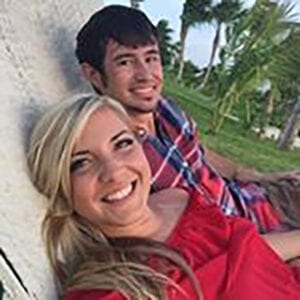 I don’t want to discourage anybody from doing work during the month of August if they have stuff they need to get done and I’m doing the exact same thing. I got a new property. I’ve been hunting Ohio because I hunt Ohio now too. I hunted the same property for a few years. It’s a 40-acre property. I lost my access to that property at the end of this past season. I ended up getting a new property that was about 45 minutes away from there still in Southern Ohio. I gained access to it. It’s a new place I’ve never been on in my life. Obviously, I’ve never hung a stand there. The season opens up. I don’t know exactly when Ohio’s opener is, but it’s usually right around the end of September, right around the beginning of October, sometime in there.
I don’t want to discourage anybody from doing work during the month of August if they have stuff they need to get done and I’m doing the exact same thing. I got a new property. I’ve been hunting Ohio because I hunt Ohio now too. I hunted the same property for a few years. It’s a 40-acre property. I lost my access to that property at the end of this past season. I ended up getting a new property that was about 45 minutes away from there still in Southern Ohio. I gained access to it. It’s a new place I’ve never been on in my life. Obviously, I’ve never hung a stand there. The season opens up. I don’t know exactly when Ohio’s opener is, but it’s usually right around the end of September, right around the beginning of October, sometime in there.
If I don’t get in there and do that stuff now, I’m not going to. I like to hunt from permanent sets more than I like to do hanging hunts because there’s more that can go wrong. You can clink a stand and boom, it’s over. If you’re trying to go in there and do a hang and hunt. I still like hang and hunts and I’ve done that. That’s how I killed that deer last time here at home. If I can hunt from a permanent stand that I’ve already got set and honed and it’s ready to go, I’d much rather do that because there’s less that can go wrong. Even though I’m not doing a lot of in the field aggressive stuff here at home where I’ve already had longstanding permission in places that I’m hunting for multiple years, for consecutive years.
That’s one thing. This is a property that I’ve never even looked at, never been on, never hunted, never put a stand on it and never put a camera on it. I went up there. Me and my hunting buddy, we scoured the property. We didn’t get to look at all of it, but we looked at a lot of it. The areas that were the most attractive via aerial anyway. This property is 80 acres but we scoured that property, look, tried to network the trails as fast as we could, look for deer sign tracks, old rubs, old stripes. We put out five, six, seven camera locations. The next time when we go up there, we’re going to be hanging stands. That is going to be in probably a week or two. In an instance like that, if somebody who gains permission or gets access to a property, I would still do all those things, especially if you’ve never been on the property because you don’t know what you don’t know. It’s much better to go in there maybe once at most twice and scout, learn the property and get your stance home. It’s much better to do that than to blindly hunt a farm and not knowing anything about it.
You got a lot of information from Josh in this segment. This is going to be a three-part segment. Josh has graciously said that he would do this. We’re going to wrap up the August prep part. If you read this, re-read it and read it again, you’re going to pick up some nuggets that will help you for the upcoming season. Josh, we’ll be right back at you. Thanks so much.
Thank you.
Important Links:
- Josh Honeycutt
- Realtree.com
- onX
- HuntStand
- Scout
- https://www.Realtree.com/turkey-blog-with-steve-hickoff/video-how-to-get-women-into-hunting
- https://www.Realtree.com/brow-tines-and-backstrap/20-deer-hunting-lies-your-granddaddy-told-you
- https://www.Realtree.com/users/jhoneycutt
- https://www.Facebook.com/thedeerguy/
About Josh Honeycutt
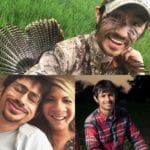 Josh Honeycutt is a back-country deer hunter from Kentucky who grew up slinging arrows and bullets at pressured river bottom whitetails. If it’s deer or turkey season, you’ll find him high in an oak tree or sitting up against one. And he enjoys spending that time in the outdoors with his wife, Kathryn, as well as the rest of his family and friends.
Josh Honeycutt is a back-country deer hunter from Kentucky who grew up slinging arrows and bullets at pressured river bottom whitetails. If it’s deer or turkey season, you’ll find him high in an oak tree or sitting up against one. And he enjoys spending that time in the outdoors with his wife, Kathryn, as well as the rest of his family and friends.
Josh has hunted the prairie whitetails of Kansas to the river bottom bucks of Kentucky to the pine-dwelling deer of South Carolina. Simply put, he loves to hunt deer. And it doesn’t matter where, either.
His passion for the outdoors led to a career as an outdoor writer, photographer, and videographer. Josh has been a regular contributor to Realtree.com since 2012 and came on board as the associate editor and deer hunting editor in July of 2015. He writes the Brow Tines and Backstrap blog. His work has been published in nearly 50 publications and websites including Field & Stream, Outdoor Life, North American Whitetail, Whitetail Journal, Game & Fish, Fur-Fish-Game, and more.
